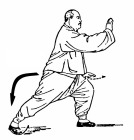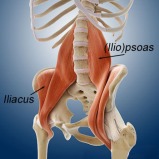When you first begin tai chi and qigong, you spend most of your time trying to remember the positions of arms and legs in the various postures, and then which posture follows the previous one.
Gradually you begin to know a repertoire of postures, one following another; in other words – the tai chi ‘form’, or a qigong ‘set’ of exercises.
 At first this ends up as though you are physically reproducing a series of photographs; you move the body into the position of one photo, then another, until you’ve got to the end.
At first this ends up as though you are physically reproducing a series of photographs; you move the body into the position of one photo, then another, until you’ve got to the end.
You’ve now learnt the shape of the form – the equivalent of a musician learning which note follows which, but without any great fluency, interpretation, or subtlety.
Then there’s all that talk about ‘flow’… ‘flowing’ from one position to another. How do you do it? How do you smoothly transition between one movement and another?
This could be referred to as the ‘connection’.
Connecting the moves.
Connection is relaxation and continuation. It is understanding what the energy of a movement is doing and how to convert it into something new.
In fact, we are continuously using this skill in many varied situations.
- If friends are upset, we listen to them so as to help them convert their discomfort and see them through the problem.
- If you’re driving your car around a 90 degree bend, you ease off on the corner in order to make the transition.
- If you want to jump on a bus that’s passing you, you run alongside the bus before jumping on, rather than grabbing the handrail as it passes.
What takes place in all instances is a ‘listening’ to the first action in order to change it into the second action. By doing so, you blend one action into another.
Let’s say you are starting in a left or right Bow stance (one leg ahead of the other, with the weight on the front leg – graphic 1, above); you are going to sit back on to your back leg (graphic 2), and then go forwards again into the same Bow stance that you started in (graphic 3). You can ignore the hand positions.
Having sat back (graphic 2), the energy which has been going backwards needs to reverse, but without going directly forwards along the same ‘line’ that you sat back on. If you do this, there will, in effect, be a ‘break’ in the movement, i.e. at the exact point where you finish sitting back prior to going forward again. Trying to do that is like reaching your 90 degree bend in the road and attempting to do an abrupt right angle turn, i.e. missing out the curve of the bend. The car would roll over.
- As you start to sit backwards, the back knee gradually bends. Be
 aware that the direction of ‘flow’ is backwards (in this case), and that movement mustn’t stop – although it might change direction. You are gradually tilting your pelvis (draw in your abdomen).
aware that the direction of ‘flow’ is backwards (in this case), and that movement mustn’t stop – although it might change direction. You are gradually tilting your pelvis (draw in your abdomen). - As you get near to the end of sitting back, think of relaxing the leg you’ve sat back on; you are actually relaxing the hip joint, but it’s easier to think of relaxing the leg. (This is the right leg in graphic 2). Your pelvis is continuously tilting and ‘tucking under’.

- Soften your shoulders, elbows, (and hips) so that the ‘backwards’ energy/movement drops.
- Make sure that you are breathing either in or out, it doesn’t matter which. When you hold your breath the body can only partially relax; apart from anything else, the muscles don’t get the oxygen they need to stay elastic.
- As you begin to reach the maximum amount that your bent rear knee can comfortably support you, your pelvis has tilted to its full amount. Then begin to move forwards again.
What is now happening is that the body/centre is no longer moving backwards and forwards along the same horizontal line, it is now creating a circle.







